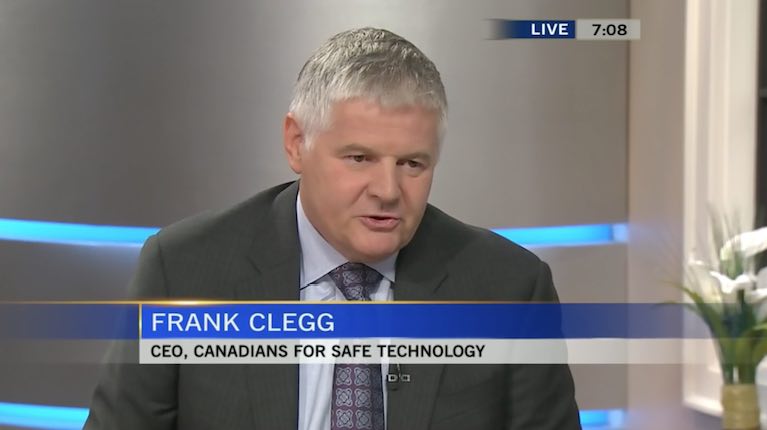Published Wednesday, July 9, 2014 2:26PM EDT
Last Updated Thursday, July 10, 2014 7:29AM EDT
Health Canada’s proposed update to its safety code for wireless radiation exposure ignores current research and “fails to protect Canadians from their own cellphones,” say experts.
A group of Canadian physicians has written to Health Canada about Safety Code 6, the microwave radiation safety guidelines policy. The federal government has invited public comment on its proposed changes, and the doctors, along with a non-profit group called Canadians for Safe Technology (C4ST), say they fail to factor in dozens of studies that demonstrate the harmful effects of exposure to everyday technology: cellphones, baby monitors, and even cars and refrigerators.
“Our very strong message is that this safety code fails to protect Canadians from their own cellphones,” Frank Clegg, CEO of C4ST, told an Ottawa news conference.
“It fails to protect children from all-day WiFi in schools, it fails to protect anyone from a cell tower or a smart meter that may be located across the street or outside the window of their home or office building.”
Safety Code 6 was first developed before the Internet existed, Clegg said.
“It is outdated and it failed to keep up with the times,” he said. “More importantly, it has failed to keep up with the established science.”
A handful of countries have already updated their guidelines for exposure to wireless radiation, including Russia, China, Italy and Switzerland. In these countries, Clegg said, citizens “enjoy safety limits 100 times more stringent” than in Canada.
Health Minister Rona Ambrose said in a statement that: “Canada’s limits are similar to those of the United States, Australia, the European Union and Japan.”
Three requests
For its update, Health Canada has ignored more than 130 studies that demonstrate that wireless devices can cause harm even at very low levels, Clegg said. These include links between radiation exposure and cancer, genetic damage, infertility, developmental impairment and cardiovascular health.
“Health Canada gets an ‘F’ for effort on this update to Safety Code 6,” Clegg said.
More than 20 physicians have put their names on the declaration to Health Canada that makes three requests. That the federal agency:
- Develop and implement strategies to raise awareness about microwave radiation impacts and minimize exposure in schools and other places where children face regular exposure.
- Conduct a comprehensive review of research into the effects of wireless radiation exposure that includes all ages and relies less on industry-funded studies.
- Provide guidelines and resources for physicians so they can better recognize symptoms possibly related to microwave exposure.
“There is considerable evidence and research from various scientific experts that exposure to microwave radiation from wireless devices; Wi-Fi, smart meters and cell towers can have an adverse impact on human physiological function,” the physicians write in their submission to Health Canada.
“Many recent and emerging studies from university departments and scientific sources throughout the world support the assertion that energy from wireless devices may be causatively linked to various health problems including reproductive compromise, developmental impacts, hormonal dysregulation and cancer.”
Canada ‘a generation behind’
The period of public comment follows the release last April of a report by an expert panel into the adequacy of the Safety Code 6 guidelines.
The eight-member Royal Society of Canada panel was tasked by Health Canada will be reviewing the guidelines and recommending any necessary changes based on the latest research.
The panel concluded that the current guidelines are adequate.
“The conclusion of the panel was that the Safety Code 6 limits are science-based and are designed to avoid all known hazards of radiofrequency radiation,” said panel chair Paul Demers, director of the Occupational Cancer Research Centre in Toronto.
“And we do not believe at this time that additional precautionary measures should be introduced directly into the exposure levels or limits.”
However, the panel did say that Health Canada should look more closely at research into whether radiofrequency waves from wireless devices such as smartphones are linked to cancer.
“That certainly is one of the areas that has arisen as a concern,” Demers said in April.
Clegg and the group of physicians say they are also concerned about a condition called electromagnetic hypersensitivity (EMS), which is caused by exposure to radio waves.
Symptoms range from severe headaches and nausea to heart palpitations, and are only alleviated when they stay away from radiation-emitting devices.
Sharon Deoux of Gatineau, Que., lived next to hydro wires for more than 20 years before selling her home. She describes herself as “electro-sensitive” and says she feels pain when exposed to signals from electronics and wireless devices.
“What I feel is difficulty breathing, pressure on my chest, and the pressure can grow so it’s really very strong,” she told CTV News.
Now she is electronics-free.
“I don’t have a microwave oven, anywhere, just an ordinary oven, and fridge, no dishwasher even, because I have a minimum of machines,” she said.
Dr. Riina Bray of the Environmental Health Clinic at Women’s College Hospital said the federal government should exercise “the precautionary principle” and update the guidelines before “huge epidemics of illness” occur.
“We are seeing blatant disregard for people suffering from symptoms related to Wi-Fi and other wireless technology,” Bray told CTV News.
With a report from CTV’s Katie Simpson in Ottawa
https://www.ctvnews.ca/canada/wireless-radiation-exposure-code-fails-to-protect-canadians-1.1906165
medical-doctors-submission-to-health-canada-english

